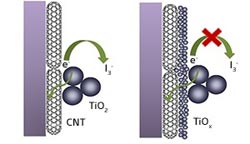Solar cells: A clear choice

Carbon nanotube electrodes. The use of carbon nanotubes has a significant cost advantage. However, in earlier designs (left), the carbon nanotubes degraded through chemical processes (e-: electrons, I3-: ions in the liquid). Using a thin protective layer of titanium oxide now stabilizes the nanotubes (right), increasing the performance of these cells. Copyright : 2011 AIP<br>
Solar energy is one of the most promising forms of renewable energy, but the high cost of conventional solar cells has so far limited its popularity.
To increase the competitiveness of solar energy, scientists have turned to the development of dye-sensitized solar cells — solar cells that use low-cost organic dyes and titanium dioxide (TiO2) nanoparticles in place of expensive semiconductor and rare earth elements to absorb sunlight.
Zhaohong Huang at the A*STAR Institute of Materials Research and Engineering and co-workers1 have now reduced the cost of dye-sensitized solar cells even further by replacing indium tin oxide (ITO) — the standard material for transparent electrodes — with carbon nanotubes.
A typical dye-sensitized solar cell comprises a porous layer of TiO2 nanoparticles immersed in an organic dye. The dye absorbs the sunlight and converts the energy into electricity, which flows into the TiO2 nanoparticles. The sun-facing side of the solar cell is usually covered with a transparent electrode that carries the charge carriers away from the TiO2 and out of the solar cell. “Unfortunately, ITO electrodes are brittle and crack easily,” says Huang. “They are also expensive and could incur up to 60% of the total cost of the dye-sensitized solar cell.”
Huang and his team therefore replaced the ITO electrode with a thin film of carbon nanotubes. Carbon nanotubes conduct electricity and are almost transparent, flexible and strong, which make them the ideal material for transparent electrodes. The only drawback is that photo-generated charge carriers in the nanotube may recombine with ions in the dye, which reduces the power conversion efficiency of the solar cell.
To overcome this problem, Huang and his team placed a TiO2 thin film in between the carbon nanotube thin film and the porous layer. They found that the performance of dye-sensitized solar cells with TiO2 thin film was significantly better than those without. However, they also found that the solar conversion efficiency of their new dye-sensitized solar cells was only 1.8%, which is lower than that of conventional solar cells using ITO electrodes. This is due to the higher electrical resistances and reduced optical transparency of the carbon nanotube films, which limits the amount of sunlight entering the cell.
“We are now studying different ways to enhance the conductivity and transparency of the films,” says Huang. “Furthermore, we are planning to replace the bottom platinum electrode with carbon nanotube thin film to reduce the cost of dye-sensitized solar cells further.”
If successful, the results could have a great impact on the cost and stability of dye-sensitized solar cells.
The A*STAR-affiliated researchers contributing to this research are from the Institute of Materials Research and Engineering and the Singapore Institute of Manufacturing Technology
Media Contact
All latest news from the category: Power and Electrical Engineering
This topic covers issues related to energy generation, conversion, transportation and consumption and how the industry is addressing the challenge of energy efficiency in general.
innovations-report provides in-depth and informative reports and articles on subjects ranging from wind energy, fuel cell technology, solar energy, geothermal energy, petroleum, gas, nuclear engineering, alternative energy and energy efficiency to fusion, hydrogen and superconductor technologies.
Newest articles

A universal framework for spatial biology
SpatialData is a freely accessible tool to unify and integrate data from different omics technologies accounting for spatial information, which can provide holistic insights into health and disease. Biological processes…

How complex biological processes arise
A $20 million grant from the U.S. National Science Foundation (NSF) will support the establishment and operation of the National Synthesis Center for Emergence in the Molecular and Cellular Sciences (NCEMS) at…

Airborne single-photon lidar system achieves high-resolution 3D imaging
Compact, low-power system opens doors for photon-efficient drone and satellite-based environmental monitoring and mapping. Researchers have developed a compact and lightweight single-photon airborne lidar system that can acquire high-resolution 3D…





















